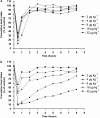PEGylated cholecystokinin prolongs satiation in rats: dose dependency and receptor involvement
- PMID: 17618299
- PMCID: PMC2042956
- DOI: 10.1038/sj.bjp.0707390
PEGylated cholecystokinin prolongs satiation in rats: dose dependency and receptor involvement
Abstract
Background and purpose: Acute intraperitoneal (i.p.) administration of cholecystokinin (CCK) is known to induce a significant, but short-lasting, reduction in food intake, followed by recovery within hours. Therefore, we had covalently coupled CCK to a 10 kDa polyethylene glycol and showed that this conjugate, PEG-CCK(9), produced a significantly longer anorectic effect than unmodified CCK(9). The present study assessed the dose-dependency of this response and the effect of two selective CCK(1) receptor antagonists, with different abilities to cross the blood-brain barrier (BBB), on PEG-CCK(9)-induced anorexia.
Experimental approach: Food intake was measured, for up to 23 h, after i.p. administration of different doses (2, 4, 8, 16 and 32 microg kg(-1)) of CCK(9) or PEG-CCK(9) in male Wistar rats. Devazepide (100 microg kg(-1)), which penetrates the BBB or 2-NAP (3 mg kg(-1)), which does not cross the BBB, were coadministered i.p. with PEG-CCK(9) (6 microg kg(-1)) and food intake was monitored.
Key results: In PEG-CCK(9)-treated rats, a clear dose-dependency was seen for both the duration and initial intensity of the anorexia whereas, for CCK(9), only the initial intensity was dose-dependent. Intraperitoneal administration of devazepide or 2-NAP, injected immediately prior to PEG-CCK(9), completely abolished the anorectic effect of PEG-CCK(9).
Conclusions and implications: The duration of the anorexia for PEG-CCK(9) was dose-dependent, suggesting that PEGylation of CCK(9) increases its circulation time. Both devazepide and 2-NAP completely abolished the anorectic effect of i.p. PEG-CCK(9) indicating that its anorectic effect was solely due to stimulation of peripheral CCK(1) receptors.
Figures



Similar articles
-
PEGylated cholecystokinin is more potent in inducing anorexia than conditioned taste aversion in rats.Br J Pharmacol. 2008 Oct;155(3):417-23. doi: 10.1038/bjp.2008.257. Epub 2008 Jun 23. Br J Pharmacol. 2008. PMID: 18574458 Free PMC article.
-
PEGylation of cholecystokinin prolongs its anorectic effect in rats.Peptides. 2007 May;28(5):1003-11. doi: 10.1016/j.peptides.2007.02.009. Epub 2007 Feb 15. Peptides. 2007. PMID: 17379357
-
Lack of tolerance development with long-term administration of PEGylated cholecystokinin.Peptides. 2009 Apr;30(4):699-704. doi: 10.1016/j.peptides.2008.11.010. Epub 2008 Nov 25. Peptides. 2009. PMID: 19084041
-
[Peptides of digestive system and brain. Model of the cholecystokinin].Ann Endocrinol (Paris). 1988;49(2):113-20. Ann Endocrinol (Paris). 1988. PMID: 3048188 Review. French.
-
Role of cholecystokinin in satiation: a systematic review and meta-analysis.Br J Nutr. 2023 Jun 28;129(12):2182-2190. doi: 10.1017/S0007114522000381. Epub 2022 Feb 14. Br J Nutr. 2023. PMID: 35152916
Cited by
-
Beneficial effects of the novel cholecystokinin agonist (pGlu-Gln)-CCK-8 in mouse models of obesity/diabetes.Diabetologia. 2012 Oct;55(10):2747-2758. doi: 10.1007/s00125-012-2654-6. Epub 2012 Jul 20. Diabetologia. 2012. PMID: 22814764
-
PEGylated cholecystokinin is more potent in inducing anorexia than conditioned taste aversion in rats.Br J Pharmacol. 2008 Oct;155(3):417-23. doi: 10.1038/bjp.2008.257. Epub 2008 Jun 23. Br J Pharmacol. 2008. PMID: 18574458 Free PMC article.
References
-
- Abuchowski A, McCoy JR, Palczuk NC, van Es T, Davis FF. Effect of covalent attachment of polyethylene glycol on immunogenicity and circulating life of bovine liver catalase. J Biol Chem. 1977a;252:3582–3586. - PubMed
-
- Abuchowski A, van Es T, Palczuk NC, Davis FF. Alteration of immunological properties of bovine serum albumin by covalent attachment of polyethylene glycol. J Biol Chem. 1977b;252:3578–3581. - PubMed
-
- Ankeny DP, McTigue DM, Guan Z, Yan Q, Kinstler O, Stokes BT, et al. Pegylated brain-derived neurotrophic factor shows improved distribution into the spinal cord and stimulates locomotor activity and morphological changes after injury. Exp Neurol. 2001;170:85–100. - PubMed
-
- Bado A, Durieux C, Moizo L, Roques BP, Lewin MJ. Cholecystokinin-A receptor mediation of food intake in cats. Am J Physiol. 1991;260:693–697. - PubMed
-
- Baldwin BA, de la Riva C, Gerskowitch VP. Effect of a novel CCKA receptor antagonist (2-NAP) on the reduction in food intake produced by CCK in pigs. Physiol Behav. 1994;55:175–179. - PubMed
Publication types
MeSH terms
Substances
LinkOut - more resources
Full Text Sources
Other Literature Sources
Research Materials

